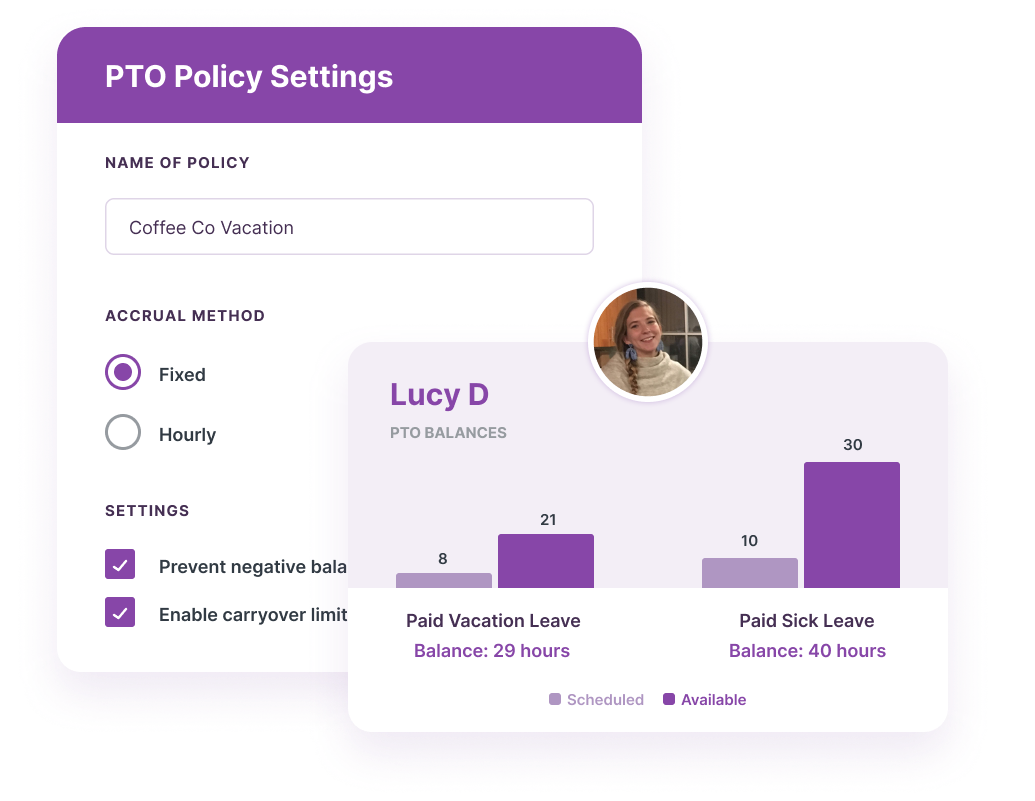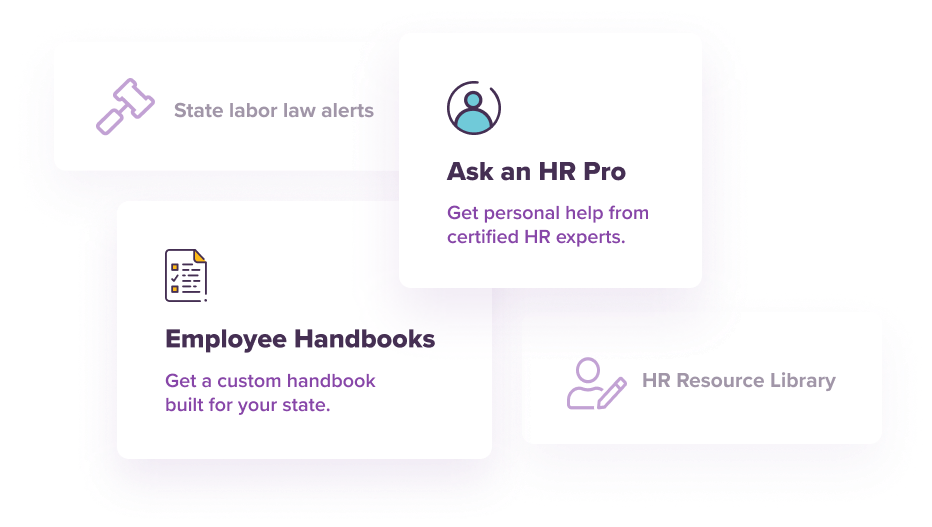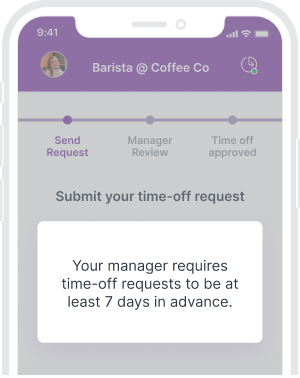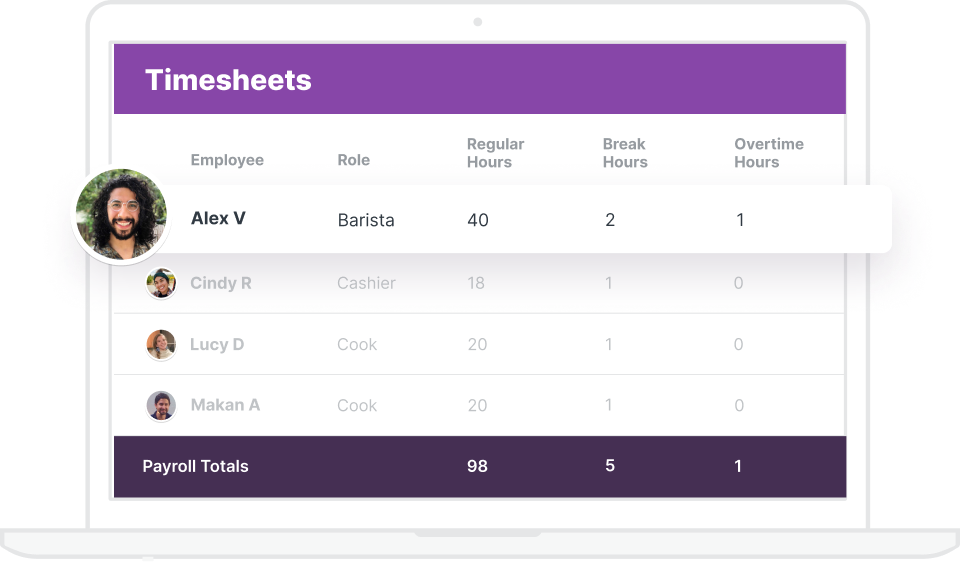Paid time off (PTO): your small business questions answered
- Paid time off gives your employees the chance to take personal time if they are sick, want to go on vacation, or simply need a day off.
- While there is no required federal paid leave, many states have their own paid leave policies in place.
- Using a trusted time clock software like Homebase can help you track hours and determine how much paid leave your employee can accrue.

What is paid time off and personal time off?
Paid time off (PTO), or personal time off, is time given to employees by an employer to be taken at the employees’ leisure. As the name implies, PTO are paid days off, meaning the employee is compensated by their employer. Many businesses offer more annual PTO as a benefit the longer an employee has been with that company.
While some business owners choose to offer separate categories of days off, like paid sick leave, vacation time, and more, a PTO (paid time off) policy combines those buckets into a single bank of either accrued paid time off or a certain number of hours per year.
This means the employee uses this PTO balance whenever they need to take time off work, regardless of the reason, at their own discretion. Paid time off for hourly employees can provide benefits for both your team members and yourself as a business owner or manager.
Since employees can schedule time off in advance instead of relying on last-minute shift swapping or a spread of hours, you’ll have more time to cover the work and won’t have to worry as much about unscheduled absences, buddy punching, or time theft, which can pose a huge problem.
PTO also provides a good amount of flexibility, giving employees the option to use their leave when they need it. This prevents your team from feeling like they have to lie because they don’t want their managers to know why they’re taking off.
If you use a mobile app like Homebase to manage your time-off requests, offering PTO is easy. Business owners and managers can easily track employee availability, time-off requests, approvals, and more in the Homebase free online schedule maker.

Paid time off laws
Paid time off is different from unpaid leaves that are required by the United States government under the Family and Medical Leave Act. However, some states also require you to offer paid leave on top of the federal rules.
For example, California’s Paid Family and Medical Leave requires employers to provide full time employees 8 weeks of paid family leave within a one-year period (52 weeks) to take care of a new child or care for a seriously ill family member.
Colorado also recently implemented a law that requires employers to provide at least 1 hour of paid sick time for every 30-hour pay period an employee works. The accrued time must add up to 48 hours per year.
Some states require 80 hours or 40 hours of paid leave per year, or a certain number of days vacation time. Other states that require paid leave include Connecticut, Massachusetts, New Jersey, New York, Oregon, Rhode Island, Washington, and Washington D.C. Check your Homebase state labor law guide to learn more about what’s required in your area.
If you live in a state that has a paid leave law but do not currently have a paid time off policy in place, Homebase can help. When you sign up for HR Pro, you’ll receive live access to certified HR experts who can help you build your policy, provide paid time off policy samples, template, review your employee handbook, and more.

Barzotto
Marko Sotto
Owner at Barzotto

Paid time off (PTO) best practices
There are many things you can implement into your PTO policy to make it attractive for potential employees, or to increase employee retention.
For starters, you can make your policy flexible, bundling together all types of leave into one PTO bank and allow employees to take the days off when they need them. The flexibility will convey that you trust your employees and don’t feel the need to have control over this area of their work.
Take a look at the culture of your team and how your industry works to determine which type of PTO policy would work best for everyone involved. Understanding your employees and what they need will help you make the best decision. Consider running a survey among your team members to learn what they would prefer.
It’s also important to make your policy understandable and clearly defined. Your team should never be confused about what is available to them, what is allowed, and what is not allowed. Be sure to clearly explain your policy and provide as much detail as possible. Once you’ve got the defined policy in place, make sure it’s accessible to everyone that works for you.
You might even consider creating a paid time off policy PDF that your team can download and save on their device should they ever need to reference it.
Again, HR Pro can help you determine the best paid time off policy for hourly workers and for your business. Sign up to get started today.

How do I calculate paid time off & personal time off?
Learning how to calculate paid time off for hourly employees is a big step in preparing to offer the benefit. You can use a paid time off accrual software, or PTO tracking software, but here’s how to do it on your own.
If you provide PTO based on the number of hours your employee worked, which works best for hourly employees, you can divide the number of annual PTO hours by the number of annual work hours. Let’s say an hourly employee earns 80 hours of PTO annually and works 40 hours a week.
That would mean they work 2,080 per year, so you would divide 80 by 2,080 to determine how much PTO they earn per hour. The answer would be .038 PTO hours per hour worked.
With Homebase timesheets, you can track how many hours your employee works to make it easier when calculating paid time off hours accrued.
Instead of running the risk of buddy punching with a punch clock, you can also use our small business time clock, a time and attendance software that works to ensure all aspects of your time tracking are running smoothly. We’ll also track breaks so you can ensure compliance, even for your remote workers with our GPS time clock.

Paid time off FAQs
What are the benefits of paid time off?
Paid time off or personal time off, can benefit both the employer and the employee. As an employee it is an added benefit, and companies that offer an accrual in PTO can incentivize employees to stay with that company for longer.
As an employer, PTO increases company culture, employee well-being, and helps reduce things like unscheduled absences and time theft. Similar to offering health care, it is an added benefit for employees.
Is paid time off the same as vacation?
No, PTO and vacation are not the same things. Paid time off can be used as vacation by an employee, but does not have to be used as vacation. The employee can use PTO for sick days, bereavement leave, doctors appointments, a day running errands, or whatever else the employee decides. This is why paid time off is also called personal time off.